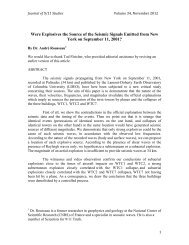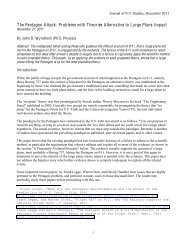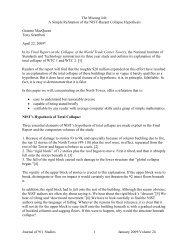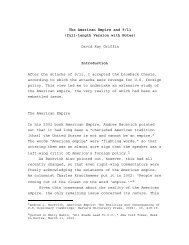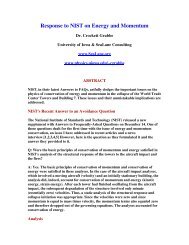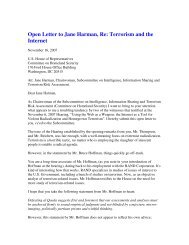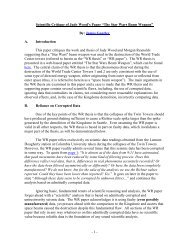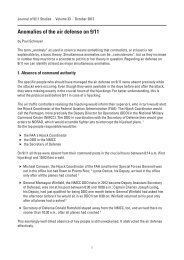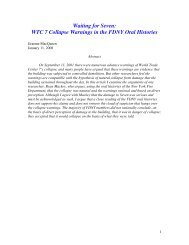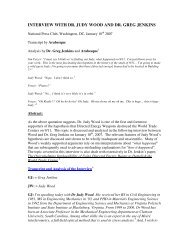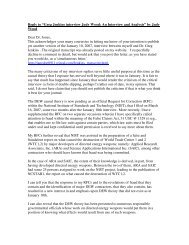A Brief Analysis of Dr. Judy Wood's Request for Correction to NIST ...
A Brief Analysis of Dr. Judy Wood's Request for Correction to NIST ...
A Brief Analysis of Dr. Judy Wood's Request for Correction to NIST ...
You also want an ePaper? Increase the reach of your titles
YUMPU automatically turns print PDFs into web optimized ePapers that Google loves.
“This is not a collapse and it is fraudulent <strong>to</strong> have so stated.” 44Fraudulence assumes motive. That is, fraud is the deliberate deception practiced <strong>for</strong> thepurpose <strong>of</strong> gain. This accusation appears peppered throughout her publication withoutevidence supporting the claim. Wood has presented an incredibly weak case <strong>for</strong>indictment by leaving <strong>NIST</strong>’s motives unidentified.Billiard balls: a case study in the violation <strong>of</strong> the conservation <strong>of</strong> momentumBilliard ball analysis in Figures 6, 7, and 8Duration <strong>of</strong> collapse: confusion <strong>of</strong> collapse times“The WTC <strong>to</strong>wers were destroyed faster than it would take them <strong>to</strong> drop <strong>to</strong> the ground infree-fall” 45“The near free-fall timeframe <strong>of</strong> destruction” 46<strong>Dr</strong>. Wood quotes the August Fact Sheet (Answers <strong>to</strong> Frequently Asked Questions) by<strong>NIST</strong> in stating:“<strong>NIST</strong> estimated the elapsed times <strong>for</strong> the first exterior panels <strong>to</strong> strike the ground afterthe collapse initiated in each <strong>of</strong> the <strong>to</strong>wers <strong>to</strong> be approximately 11 seconds <strong>for</strong> WTC 1and approximately 9 seconds <strong>for</strong> WTC 2.” 47However, she quotes <strong>NIST</strong>: “Within 12 seconds, the collapse <strong>of</strong> WTC1 had left nothingbut rubble.” 48 That is, 12 seconds compared with free fall <strong>of</strong> 9.2 seconds—contradictingher own argument that the buildings fell faster than free fall speed.Many <strong>of</strong> the perceived discrepancies in the <strong>NIST</strong> report collapse times arise fromconfusion between ‘collapse time’ and the time it takes <strong>for</strong> the first piece <strong>of</strong> debris <strong>to</strong> hitthe ground once collapse initiates. The fall time <strong>for</strong> debris in the vicinity <strong>of</strong> the impactzone where the first pieces <strong>of</strong> debris begin falling from the building is much shortercompared <strong>to</strong> the fall time <strong>of</strong> the ro<strong>of</strong>. <strong>Dr</strong>. Wood attempts <strong>to</strong> use the shorter 9 secondsquoted by <strong>NIST</strong> as a ‘collapse time’ and erroneously argues that the data shows that,assuming the debris did not magically accelerate faster than g, some <strong>of</strong> the debris musthave vanished be<strong>for</strong>e it hit the ground thus shortening the perceived fall time.She attempts <strong>to</strong> substantiate her claim that the measured collapse times were much <strong>to</strong>oshort by showing pictures <strong>of</strong> raw seismic graphs (figure 3) and states:“Columbia University’s Seismology Group recorded seismic events <strong>of</strong> 10 and 8 secondsin duration, which correspond <strong>to</strong> the collapses <strong>of</strong> WTC2 and WTC1, respectively.”It has been shown, repeatedly, that seismic graphs do not effectively measure the energyreleased from a building collapse. There is no simple correlation between the potential



